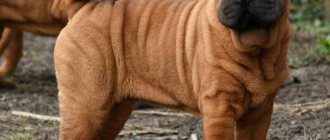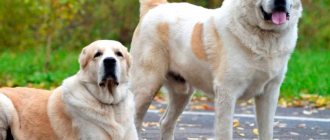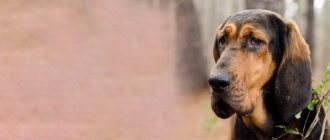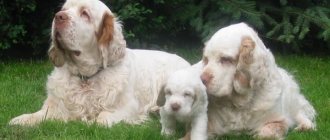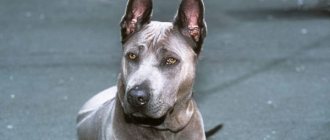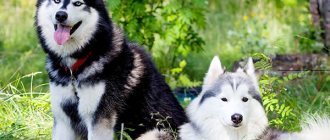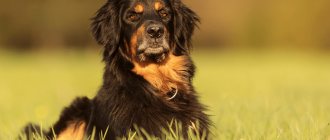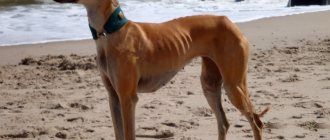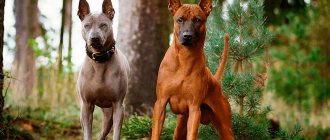This breed of dog is considered the most amazing and most mysterious. In addition, if earlier this breed was considered rare, in our time this cannot be said, although it has not lost its uniqueness. Due to its unique appearance, this breed cannot be confused with any other breed. For many years, experts were at a loss because they did not know what breed of dog to classify it as. In addition, Shar Peis were considered close relatives of the Arctic Spitz. Thanks to the enormous achievements of science, quite recently, as a result of a study of their genotype, it was possible to determine that Shar Peis belong to the Molossians, and this in turn indicates the antiquity of the origin of this dog breed.
Standards: description and photos of dogs
The Shar Pei is a Chinese breed that lived for centuries and millennia on the shores of the South China Sea and was bred in the Kwong Tun province.
Shar Pei dogs are very active. Their body is medium in size, well built, and shaped like a square. The Shar Pei can be immediately recognized by the folds on the head and withers. Their ears are small compared to the size of their head, which is often called a “hippopotamus.”
By nature, these animals are calm and independent, loyal to others, but at the same time devoted to their owner.
In accordance with the FCI standard, the following distinctive characteristics of the breed are distinguished:
- The Shar Pei's head is large and wide, no sharp points are observed on the muzzle. The lips and nose look a little swollen. The eyes are almond-shaped, giving a frowning look, and are usually dark in color. The ears are small in size and fit tightly to the skull. The standard does not allow erect ears.
- The body in adulthood should be moderately covered with folds. Their presence is allowed only on the withers and at the base of the tail.
- The Shar Pei's tail is thick at the base and gradually tapers towards the end, while being set high. It can be curved or twisted, and also directed towards the back or to the side.
- The Shar Pei's limbs are very strong and muscular. There are no folds on the front legs, as well as on the thighs, legs and ankles.
- The breed is characterized by a special type of coat. The Shar Pei's body is covered with hard, bristly hair. Its length can be from 1 to 2.5 cm.
- Dogs can be any solid color except white. As a rule, the fur on the thighs is lighter than on other parts of the body, and the muzzle may, on the contrary, be darker.
If a dog has any deviations from the above standards, then the animal is considered to have a disability or malformation if the severity is high. These serious disadvantages include:
- pointed muzzle shape;
- large ears;
- low-set tail;
- excessively long hair.
Some of the vices that serve as a reason for disqualification are:
- absence of a tail;
- erect ears;
- deep skin folds on the body;
- lack of solid color.
Next in the photo you can see photos of adult dogs of black, blue and other colors.
Health
Dogs of the Azawakh breed live in harsh places, and they also undergo selection. Accordingly, they do not have any special health problems, but only those who come from Africa. Lines from Europe are quite limited in sires, they have a small gene pool and are more pampered. Average life expectancy is 12 years.
This is one of the hardiest dogs on the planet, able to withstand high temperatures and stress. But, they do not tolerate cold very well, and must be protected from falling temperatures.
Sweaters and clothes for dogs are extremely necessary even if we are talking about autumn, not to mention winter. They have no protection from the cold, and the Azawakh freezes and gets frostbite where another dog would feel comfortable.
Weight
In accordance with the standard, the weight of adult dogs fluctuates in the following intervals:
- females - from 18 to 25 kg;
- males - from 25 to 30 kg.
Newborn puppies weigh about 500 grams, but after a month from birth their weight reaches 2.5 -3 kg. Further, Shar Peis increase their body weight every month and by the age of 12 months they almost completely reach their maximum weight (about 25 kg). But some young individuals can continue to grow for up to 15 months.
The weight of the dog must correspond to its size so that the animal looks harmonious.
Appearance of a dachshund
Dachshunds are the most recognizable breed in the world. A long and short-legged sausage dog looks ridiculous only at first glance. Dachshunds have powerful paws and a very voluminous chest. These are not large, but very strong dogs - their muscles are well developed. A strong constitution and endurance are the heritage of a centuries-old hunting past.
The long, dry head with a smooth transition from the forehead to the muzzle is decorated with large ears. Brown eyes always look with curiosity, remarkable intelligence is visible in them.
Coat type
Shar Pei coats can be of three types. Representatives of the breed differ in the length and quality of their coat. Sometimes you can hear from breeders about such transitional types as:
- short brush;
- long brush;
- semi brush, etc.
Horse
This type of coat was originally characteristic of this breed. The hairs are short and quite stiff. Their length does not exceed 1 cm, they feel prickly to the touch. This type of fur often causes allergic reactions in people. Chinese breeders believe that this is the type of coat a purebred Shar Pei should have. The tail of dogs with this type of coat is covered with very short hair, which resembles a rat's tail.
Brush
The length of brush wool varies from 1 cm to 2.5 cm. It feels much softer to the touch than horse wool, but it should still be rough and not adjacent to the animal’s body. The tail, covered with such hairs, resembles a brush. In winter, the brush type Shar Pei develops a thick and dense undercoat, which disappears with the onset of spring.
To reduce the number of hairs during shedding and speed up the process, you should use special combs. Brush-type Shar-Peis may appear to be larger in size, but this is just a visual effect due to the larger coat.
Important! When breeding puppies, the horse coat type is considered dominant, and the brush coat type is considered recessive.
When breeding dogs with different coat types, puppies can be born of two types if the horse parent is a carrier of the recessive gene.
When crossing two horse breeds, brush puppies can also sometimes be produced. But if both parents have brush-type hair, then you won’t be able to get horse puppies. You can accurately determine a puppy’s coat type at the age of 2-3 months.
Bear
Bear hair is the longest - more than 2.5 cm. Puppies with this type of hair are born only from parents who are both carriers of the recessive gene for this type of hair. The bear has been known for a very long time. The genes for this coat originate from the first dogs of this breed, which were brought from China in 1973. Bear-haired Shar Peis are very similar in appearance to the Chow Chow breed. The folds under the abundant layer of wool are practically invisible.
Only the CSPCA recognizes a third coat type for this breed.
The FCI standard considers hair longer than 2.5 cm to be a serious fault of the breed and such animals are not allowed to participate in show class exhibitions. Bear-haired Shar Peis may only be shown to evaluate obedience and agility.
Hortaya Greyhound: a brief historical background
The history of the Russian Horta Borzoi has deep eastern roots; the ancestors of these dogs were brought to the Black Sea steppes by Asian nomads in ancient times. Over the course of many centuries, the modern image of an ideal, universal greyhound dog was formed by crossing with other hunting breeds and selecting the best producers for working qualities.
There is not a single feature of these dogs that is not directly related to the work they do.
It is assumed that various aboriginal dogs took part in folk selection, and the priority was always placed not so much on the exterior as on the working qualities of the desired offspring. The result was a universal greyhound capable of not only hunting hares, but also poisoning roe deer, fleet-footed saigas, and participating in the hunt for wild boar, fox and even wolves; in Asia, such dogs are also used for hunting game birds.
V. I. Dahl’s dictionary interprets the origin of the word “hort” as a derivative of hurtig (translated from Old German - fast, agile). In Russia, Horts were the name given to all hunting dogs whose purpose and type of build were similar to greyhounds. The Hortai Greyhound has been known here for at least five hundred years, and the peak of the breed’s popularity occurred in the 17th-19th centuries, when effective four-legged helpers were widely used during hunting trips by the local nobility and were kept in large packs in kennels and stables. These dogs were preferred by Empress Anna Ioanovna, a great lover of hunting.
Initially, the problem of the hard-working Hortys was that their owners did not particularly care about the purity of blood and the uniformity of the breed type. The best of the best hunters were used in breeding, whose exterior was only supposed to contribute to the implementation of the main function - to catch up and catch the animal. At the beginning of the century before last, P. M. Gubin, in his book “A Complete Guide to Canine Hunting,” created the first description of the Russian Horta Greyhound and gave a very high assessment to the qualities of this dog.
Shorthounds hunt both in groups (packs) and alone
The first breed standard was drawn up in 1951, the latest changes to it were made by the Presidium of the RKF in 2015 - they are valid only for judging on Russian territory, since the breed is not recognized by the FCI. The Hortai Greyhound is classified in the third section of the tenth group and necessarily requires working tests.
Since 2002, the National Horta Greyhound Breed Club has been operating under the Russian Canine Federation, which has been substantively engaged in stabilizing the livestock, popularizing the domestic breed and seeking its recognition by the FCI.
Color
According to the standard, Shar Peis can be any solid color. Initially, the color palette was not very wide, but in 2005 changes were made to the registry and a complete list of colors characteristic of this breed was established.
All colors are divided into 3 groups:
- Group A - basic colors. Animals are distinguished by the presence of darkening in the nose area. The tongue of such dogs is dark purple or blue, and the pads of their paws are also dark in color.
- Group B - dilute colors. They lack black pigmentation on their body. Skin, nose and claws are the same tone as the fur. The eyes and tongue are lighter shades than those of the Group A breed.
- Group C - non-standard colors (breeding).
Group A includes the following types of colors:
- cream - as close to white as possible, they have too pronounced pigmentation;
- red deer - characterized by a dark fawn or dark red coat color, with age their shade becomes brighter;
- red is the most common color, it can be from rich red to light red, the main distinguishing feature is the presence of red hair, which dogs with the red deer color do not have;
- sable - visually easy to identify by the presence of a gray coating on the Shar Pei’s body, partly it is observed on the paws and face;
- black - pure black color is rare, this group includes dark brown, olive and brown Shar-Peis;
- blue - the color can be from a delicate smoky gray to a dark ash shade;
- Isabella - obtained by crossing dogs of blue and red colors, the coat has a pinkish-cream color with a blue or gray tint.
Group B includes the following types of colors:
- cream dilut - the color does not differ from ordinary cream, but there is no dark pigment on the animal’s face;
- apricot dilut - light golden-red color, derived from deer;
- red dilute - any red coat color of an animal without pronounced dark pigmentation, a mask on the face may be present, but be chocolate color, not black or gray;
- chocolate dilut - the color varies from light shades to more saturated ones, the tongue is lavender, the nose and paws are brown;
- lilac - rare, can be from pink-chocolate to pink-blue or smoky;
- Isabella dilute is the rarest color, grayish-pink coat without dark pigment.
The group of non-standard colors includes representatives of the spotted and black-backed breed. The first type is characterized by spots of various colors on a white background, and the second type is characterized by a black color on the back and lighter side parts of the body.
Character
Varies between dogs, some Azawakhs are braver and more stubborn, but in general the older European lines are more docile than those imported from Africa. They combine loyalty and independence, and are very attached to their family.
The Azawakh forms very strong attachments to one person, although it is normal to relate to other family members. They rarely show their emotions, and are generally quite closed; they like to spend time minding their own business. In Africa they are not paid attention to or caressed.
They are very suspicious of strangers, although with proper socialization they will be neutral towards them. Most make friends very slowly, even after long contacts. They do not accept new owners very well, and some do not accept them even after many years of residence.
Sensitive, anxious, territorial, these dogs are excellent guard dogs, ready to make a fuss at the slightest danger. Despite the fact that they prefer to contain the threat, if circumstances require they will attack.
Relationships with children depend on the specific dog; when they grow up together, the Azawakh becomes friends with him. However, running and screaming children can trigger the hunter instinct, chasing and knocking down. In addition, those dogs that are new to children are very suspicious of them and do not like noise and sudden movements. These are not dogs that enjoy having their personal space violated, rough handling, and noise.
In Africa, in villages they form packs, with a social hierarchy. They are able to live with other dogs, and even prefer them. However, in order to exist, a hierarchy must be established, most Azawakhs are very dominant and will try to take the place of leader.
This can lead to fights until the relationship works out. Once a flock forms, they become very close and in large flocks almost uncontrollable. They don't like strange dogs and can fight.
Most breeds can be trained to ignore small animals such as cats. However, they have a very strong hunting instinct that is almost uncontrollable. They will chase any animal within sight, and even if they are friends with the house cat, they can catch up with the neighbor’s cat and tear it apart.
Born to run, and to run fast, Azawakhs need a lot of exercise. It is absolutely necessary to load them up so that the bad energy goes away, otherwise they themselves will find a way out for it. They are not well suited to living in an apartment; they need space, freedom and hunting.
Potential owners should be aware of several personality traits of this breed. They do not tolerate cold well, and most Azawakhs hate water.
They don’t like even the slightest drizzle; most will bypass the tenth expensive puddle, not to mention swimming. In Africa, they found a way to cool themselves by digging holes. As a result, these are born excavators. If left alone in the yard, they can completely destroy it.
Tongue color
In Shar Peis, which belong to the main color group, the color of the tongue can only be bluish-black. In dilute colors, a lighter shade is allowed. The color of the tongue can be seen even in puppies, but some have poorly expressed pigmentation at a young age.
Important! Adult Shar Pei's tongue should be one solid color with no spots.
Shar Peis have many external distinctive features that set the breed apart from the rest. Animal lovers know that the dog with the folds is, of course, the Shar Pei. All distinctive features and characteristics are specified in the breed standard. Any discrepancies do not allow animals to participate in show class exhibitions.
Owner reviews
The Hortaya Greyhound is undoubtedly one of the best greyhounds and one of the best breeds of dogs in general, extremely attractive both for its outstanding hunting and running qualities and appearance
The Hortai Greyhound is a hunting dog, and it is its working qualities that are most valued.
The Hortai will never be consolidated as a breed as long as it remains possible to so easily obtain pedigree documents for any short-haired greyhound. After all, look, the winners of all-Russian competitions among Horty in recent years have been only mixed-breeds with greyhounds. None of these dogs appear at all-Russian exhibitions, where, as a rule, a fairly competent expert commission works.
I would like to hope that in the near future, thanks to the efforts of enthusiasts, the Russian Hortai Greyhound will finally receive international recognition. These wonderful dogs have long deserved to be known and loved throughout the world.
Puppy selection criteria
If you are puzzled by choosing a dachshund puppy, you need to know several criteria for selecting a future pet. First, look at all the kids; your choice should be an active dog with a meaningful look. These animals are very sociable, so you should not take a dachshund from a breeder if they quickly run away at the sight of people.
Often those wishing to purchase a puppy are faced with attempts to deceive, when they try to pass off a dog of a mixed breed as a dachshund. In this case, from a puppy that looks like a dachshund in childhood, a huge dog that is completely different from a dachshund can grow up. To protect yourself from deception, immediately demand to show you the puppy’s mother and documents confirming the pedigree.
Not only the external “standard” appearance of the dog, but no less the character and behavior of the animal depends on the purebred of the puppy. Not purebred mestizos have problems with the psyche and temperament, which can cause many problems for the owner.
There is little chance that among the mixed breeds you will come across a mentally stable dog, similar in temperament to a real dachshund. Depending on the class and pedigree, puppies can cost from $30 to $1,000.
Pugs, Pekingese, Pomeranians, Toy Terriers, Yorkshire Terriers, and Chihuahuas will feel good in the apartment.
Rules for when there is a puppy at home
A dachshund puppy needs proper care and education. As soon as a dachshund puppy appears in the house, all family members must adhere to certain rules and recommendations.
Let's look at them:
- All wires must be removed or hidden.
- Place all household chemicals out of reach of the dog.
- Remove any plants that are toxic to dogs. These plants include carnations, ivy and poinsettia.
- Hide your shoes, because the puppy may contract an infectious disease or be poisoned.
- If there is a cat in the house, then its bowls with food and water should be moved to the windowsill or bedside table.
- Prepare a place for the dog to rest, eat and toilet.
- Buy food and water bowls, food and toys.
- Explain to children how to behave with a puppy.
- You need to learn how to lift a puppy correctly. To do this, the puppy is held under the chest with the left palm, and the hind legs are supported with the right.
- It is forbidden to lift the dachshund under its paws, as this action can damage the pet's elbows.
- It is forbidden to let small children carry a dachshund puppy. Since puppies are very nimble, the child simply cannot hold the animal and lets it go.
By adhering to these rules, you protect the puppy from injuries and accidents.
Nutrition
The health and beauty of a dog depends on the correct diet. Naturally, the diet must be properly composed and balanced.
Pet owners disagreed. Some people believe that it is better to feed their dachshunds with ready-made food, while others prefer natural food that they prepare themselves.
Ready-made food has advantages - such nutrition is already balanced and takes into account all the needs of the animal, and the food does not require additional preparation.
Before you start feeding your dog, you need to decide what you will feed him, as this type of nutrition will need to be provided for the rest of his life.
Important! If you decide to switch your dachshund from one type of food to another, then you need to do this gradually, replacing one meal with another type of food. Mixing different types of food (food and natural food) is strictly prohibited!
How many times a day should you feed your pet? At different ages, nutritional needs are different. A pet up to three months old should eat every 4 hours. From three to 8 months, the dachshund eats three times a day. But an adult animal should eat twice a day.
Puppies need to be fed before going outside as they need to eliminate immediately after feeding. But adult dogs need to eat after a walk, when the animal can rest peacefully.
The dog definitely needs free access to water. This is especially important for those animals that eat dry food. Water plates should be at a comfortable height so that the pet does not have to bend very low, as this spoils his posture.
You definitely need to monitor the amount of food you eat, since dachshunds love to eat and tend to overeat. Overeating leads to obesity. To prevent this, you need to correctly calculate the weight of the food. The amount of food is calculated using the formula 40 g of food per 1 kg of dachshund weight. After eating, leftover food is removed.
If your pet eats natural food, it should be at room temperature (neither hot nor cold!). It is strictly forbidden to add salt and spices to food!
Let's look at a number of products that are prohibited for dachshunds:
- Chocolate can cause poisoning.
- Rabbit and chicken bones can injure the stomach and intestines or break teeth.
- Sausages and sausages can cause cirrhosis of the liver.
- Onions and garlic provoke stomach ulcers.
- Smoked, fatty, fried and salty foods are bad for the liver.
- It is forbidden to give your pet spoiled food.
The dachshund's diet should consist of the following products:
- 1/3 of the daily diet should consist of lean meat - turkey, lean beef and lamb. Meat should only be given boiled. From three months you can introduce offal into the diet.
- Fish - only sea fish, boiled and without bones.
- 20-40% should be cereals - buckwheat, oatmeal, rice porridge, rolled oats.
- Vegetables and fruits are a source of fiber, vitamins and carbohydrates. Vegetables should make up 50% of the daily diet. It is better to eat vegetables raw, chopped or grated. The exceptions are potatoes (give them only boiled) and cabbage (it is better to stew them). Fruits can be given in any form. Eliminate or limit exotic fruits. Also avoid aromatic greens such as celery and cilantro.
- Boiled eggs - 1-2 pieces per week
- Dairy products - cottage cheese, cheese, fermented baked milk, kefir, yogurt, yogurt. Milk is given only to puppies up to 4 months.
Try to follow a proper diet and your dog will be healthy and well-groomed.
Conditions of detention
Like any other pet, the dachshund requires special care and maintenance at home.
Get your puppy vaccinated right from the start. You can walk with him even before such a procedure, but you must carefully ensure that the animal does not eat anything from the ground.
These small dogs are very convenient to keep even in apartments. They will also be very happy to take you on trips and are easy to take with you due to their size.
The puppy must be given a separate place in the house. Buy a lot of toys for your dog, for example rubber ones, so he will chew toys, not your shoes.
But don’t scold the animal too much if it does gnaw your thing, this is how dachshunds learn about the world at a young age. You can easily avoid this if valuable things (shoes, fur coats, jewelry) are kept out of the dog's reach.
